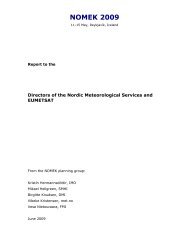International Symposium on Mitigative Measures against Snow ...
International Symposium on Mitigative Measures against Snow ...
International Symposium on Mitigative Measures against Snow ...
You also want an ePaper? Increase the reach of your titles
YUMPU automatically turns print PDFs into web optimized ePapers that Google loves.
<str<strong>on</strong>g>Internati<strong>on</strong>al</str<strong>on</strong>g> <str<strong>on</strong>g>Symposium</str<strong>on</strong>g> <strong>on</strong> <strong>Mitigative</strong> <strong>Measures</strong> <strong>against</strong> <strong>Snow</strong> Avalanches<br />
Egilsstaðir, Iceland, March 11–14, 2008<br />
FLATEYRI AVALANCHE<br />
Every<strong>on</strong>e in Iceland was shocked after the avalanches in Súðavík. A nati<strong>on</strong>al collecti<strong>on</strong> for<br />
the victims of the avalanches was organized and collected some 200 milli<strong>on</strong> Icelandic kr<strong>on</strong>as.<br />
And the rescue teams wanted to learn from this experience. On 26 th of October same year the<br />
snow tiger struck again. The c<strong>on</strong>diti<strong>on</strong>s were similar, bad weather making transportati<strong>on</strong> by<br />
air difficult. Most of the rescuers from nearby communities<br />
could go by road most of the way. A coast guard<br />
vessel left Reykjavík 3 hours after the avalanche hit.<br />
Rescuers and those in charge could draw <strong>on</strong> their<br />
experience after the avalanche in Súðavík. Around no<strong>on</strong><br />
<strong>on</strong> the 26 th , the weather improved to make it possible<br />
for helicopters to fly into the town with dogs and<br />
rescuers. But there were some differences between the<br />
two incidents. Around 13:00 hours four people had been<br />
rescued alive but after that nobody was found alive in<br />
the rubble. In Súðavík, a young boy was the last <strong>on</strong>e<br />
rescued 23 hours after the avalanche. The same incident<br />
commander and command staff were present <strong>on</strong> the<br />
scene and the experience from Súðavík gave the<br />
rescuers a plan of acti<strong>on</strong> for the rescue. The local rescue<br />
team had already started to plan the search and had<br />
rescued several victims by the time rescuers arrived<br />
from the Ísafjörður area. For the first hours, members of<br />
Flateyri rescue team worked al<strong>on</strong>e. Two rescuers were<br />
sent by snowmobile to assess the size of the avalanche.<br />
The local team <strong>on</strong>ly had 9 avalanche beac<strong>on</strong>s and <strong>on</strong>ly<br />
seven rescuers with beac<strong>on</strong>s were allowed into the area at a time. Deputy team leader of the<br />
local rescue team, Jón Svanberg Hjartars<strong>on</strong>, was in charge of the search. An hour before<br />
rescuers arrived from Ísafjörður, he allowed some rescuers to go to the lower part of the<br />
avalanche without beac<strong>on</strong>s. He and his men also used the time to gather informati<strong>on</strong> about the<br />
number of people missing. This made the work of the incident commander and command staff<br />
arriving from Ísafjörður easier when they arrived 5 hours after the avalanche struck. With the<br />
rescuers arriving from Ísafjörður came several search dogs and trained rescuers. The rescue<br />
operati<strong>on</strong> took new course with the arrival of the Ísafjörður team. The experience from<br />
Súðavík made the work easier, it was like rescuers knew exactly what to do. The command<br />
center was set up and a collecti<strong>on</strong> area for the rescuers. Maps were used to mark the<br />
avalanche and rescuers were sent out in organized groups to search. The work was like in the<br />
Súðavík disaster, a mix of avalanche and urban SAR. Dogs marked positi<strong>on</strong>s and informati<strong>on</strong><br />
about people staying in houses was used to search in the most likely areas. As menti<strong>on</strong>ed<br />
before, a coast guard ship was sent from Reykjavík, rescuers were also sent by air to the<br />
Snæfellsnes area to meet up with another coast guard vessel that was at sea. Helicopters of the<br />
Icelandic Coast Guard and United States Air Force based at the Keflavik Naval Base base<br />
managed to fly with search dogs and rescuers to Flateyri around 13:00 hours <strong>on</strong> 26 th of<br />
October. The people at Flateyri said when the helicopters arrived “It was like we were back in<br />
c<strong>on</strong>tact with rest of the world” (Arnalds, 1996). The last victim was found 36 hours after the<br />
avalanche and the last 24 hours of the rescue operati<strong>on</strong> were devoted to the search for that<br />
pers<strong>on</strong>, a little girl. The rescuers had to dig all the snow from the house she was in. It was a<br />
104 Icelandic voluntary rescue teams in the Súðavík and Flateyri avalanches in 1995











